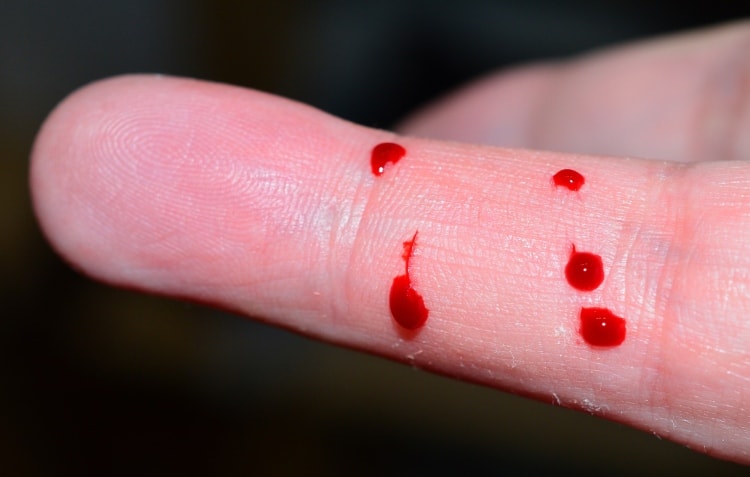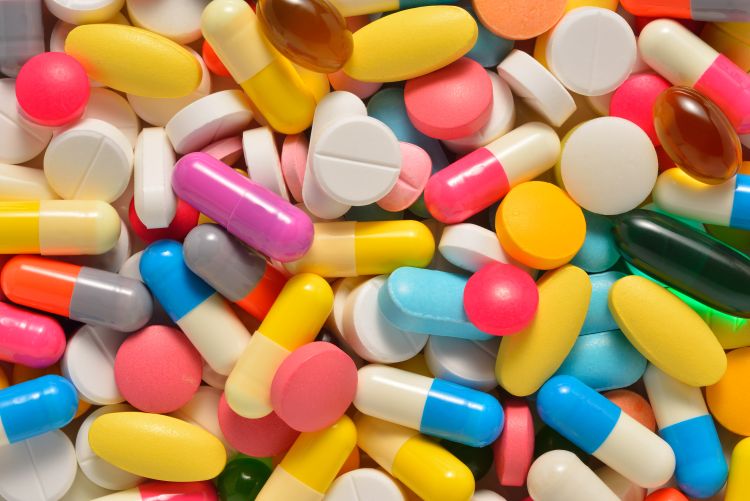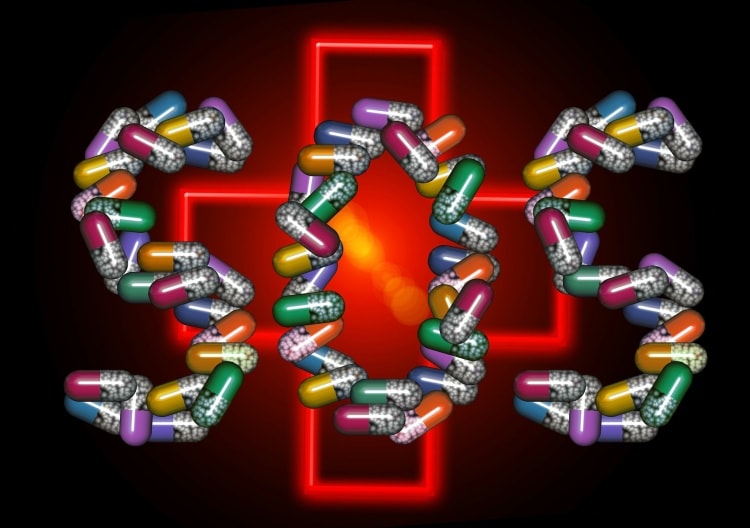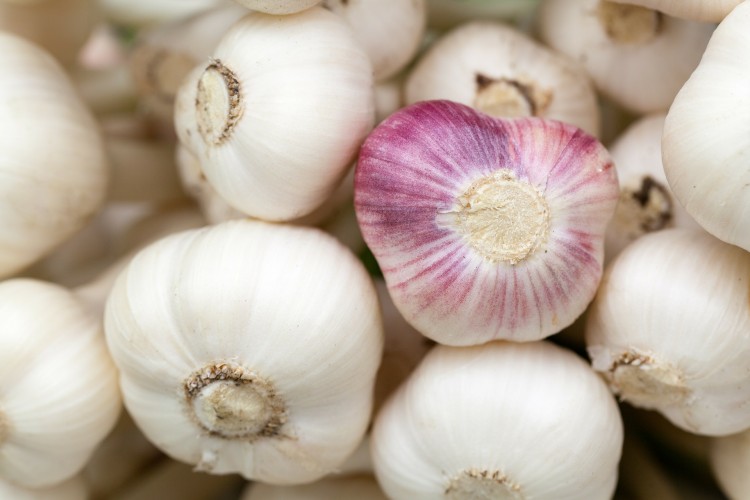Coumadin
This drug is used for the treatment of blood clots or to prevent new clots from forming (1). It is helpful during conditions such as pulmonary embolus or Deep Vein Thrombosis (DVT). Prevention of clot formation lowers the risk of stroke or heart attack (2). Medical conditions that may elevate your risk of forming blood clots include:
- A particular type of irregular heart rhythm known as atrial fibrillation
- Heart valve replacement
- Recent cardiac arrest
- Certain surgical procedures (such as hip/knee replacement).
Coumadin is usually called a "blood thinner," but the more accurate term is "anticoagulant." It assists smooth blood flow in your body by blocking the action of clotting proteins.
How to take Coumadin?
Read the dosage and medication guide thoroughly every time your doctor prescribes this medicine for you (3).
Take your Coumadin dose orally with or without food according to the instructions of your doctor or other health care professional, usually one dose per day. It is crucial to take the exact recommended dose. Do not stop using the medicine or increase the dose without consulting your doctor first.
Dosage may vary according to your condition, laboratory tests and how you respond to the medicine. Your doctor will closely observe your condition while you take this drug to determine the correct dosage for you.
Use this medicine regularly to benefit from it fully. Take your dose at the same time each day.
It is vital that you maintain a consistent diet while using this drug (4).
Some foods may affect how your body responds to Coumadin and may interfere with your treatment.
Abstain from abrupt large additions or decreases in your diet and intake of foods rich in vitamin K (such as cauliflower, spinach, brussel sprouts, kale, cabbage, and other green leafy vegetables, green tea, liver and certain vitamin supplements) (4).
If you are planning to lose weight, consult with your doctor before going on a diet.
Get emergency medical help if you have any of these signs of an allergic reaction (5):
- Hives
- Difficult breathing
- Swelling of your face, lips, tongue, or throat
Side effects of Coumadin
Like every drug, Coumadin also has its fair share of side effects. Stop using this drug and visit your doctor at once if you have a serious side effect such as (5):
- Swelling accompanied with pain, hot and cold feeling or discoloration anywhere on your body
- Intense foot or leg pain, purple fingers and toes
- Headache, dizziness and fatigue
- Sudden bleeding through mouth, nose, vagina, or rectum, bleeding that won’t stop from wounds or injection needle pricks
- Easy bruising and purplish red pin points on skin
- Bloody urine, black and tarry stools, vomiting accompanied with blood
- Rapid heart rate, labored breathing, paleness of skin
- Yellowing of skin and eyes, jaundice
- Stomach ache and pain in your back and sides
- Decrease in amount of urine
- Muscle weakness or numbness
- Diarrhea, fever, chills and weakness
Less serious side effects may include:
Coumadin precautions
Before taking Coumadin, inform your doctor about your complete medical history and allergies as you might be allergic to any of the inactive or active ingredients of this drug.
Especially, you should inform your doctor or health professional about:
- Any blood disorders that you might be suffering from such as anemia or hemophilia
- Bleeding disorders such as bleeding from stomach, nose, brain, etc.
- Blood vessel problems such as an aneurysm
- Any recent surgical procedure you might have gone through
- Hepatic disease, alcohol or drug abuse, mental disorders (including memory problems), mood swings, injuries.
It is important to inform your doctor or dentist that you are on Coumadin treatment before going through any surgical or dental procedure.
Do not get injection in your muscles. If it unavoidable, for example you have to get a flu shot, then get the injection on your arm. Then it will be easier to check for bleeding and to apply pressure bandages.
This drug may trigger stomach bleeding. Abundant and daily intake of alcohol will increase the risk of stomach bleeding and interfere with your treatment and response to coumadin.
Limit alcohol intake.
Consult your doctor or pharmacist about how much alcohol you can safely consume.
If you have lost appetite and have not been eating well, if you have a fever or diarrhea for more than two days or if you start using an antibiotic, visit your doctor as these factors may affect your treatment.
Coumadin can cause heavy bleeding. To decrease the chance of getting cut, bruised, or injured, avoid the use of sharp objects.
Use an electric razor for shaving and a soft toothbrush for cleaning your teeth. Avoid participating in contact sports in which there’s a risk of getting injured. If you happen to fall or injure yourself, especially if you injure your head, call your doctor right away.
Be careful not to use more than one medicine that has the drug warfarin unless explicitly directed by the doctor or health care professional who is monitoring your warfarin treatment.
Older patients may be exposed to more risk for bleeding while using this medicine.
Coumadin is not recommended for use during pregnancy because of serious implications that may be potentially fatal for the unborn baby. Use reliable birth control while using this medicine and if you get pregnant, inform your doctor immediately. As this drug can be absorbed into lungs through skin, pregnant mothers should not even breathe in dust of Coumadin tablets. Very minute amounts of this drug may pass into breast milk but have not been known to harm a nursing infant. Consult your doctor before breast-feeding.
Medical alternatives to Coumadin
In this section we shall take a detailed look at some of the medical alternatives to Coumadin blood thinner. Heparin, dabigatran, eliquis, rivaroxaban are the Coumarin alternatives described below.
Heparin
Heparin and Coumadin both are drugs used to prevent formation of blood clots (6). They induce smooth blood circulation by transforming the consistency of blood from thick to thin facilitating the smooth flow of blood inside the veins.
Heparin is very popular as an injectable blood thinner and is widely used. It is used for treatment and prevention of pulmonary embolism and deep vein thrombosis (together known as venous thromboembolism) and is also used as part of the therapy of unstable angina and myocardial infarction. Heparin is used on the inside surfaces of several medical devices such as dialysis machines and test tube linings (7).
Side effects of heparin
Redness, mild pain and irritation may develop at site of injection (8). If any of these things persist or worsen gradually, inform your doctor at once. Keep in mind that your doctor has prescribed this medication because he or she thinks that its benefits outweigh the risks of side effects for you. Many people do not develop serious side effects in reaction to using heparin.
Inform your doctor right away if you have any serious side effects, including: pain and swelling at injection site, pain in bones and fragile bones that are easily broken (8).
This medication can trigger heavy bleeding if its effect on your clotting proteins is too pronounced. Inform your doctor right away if you begin to show any signs of serious bleeding, including unusual swelling and pain and prolonged bleeding from gums and teeth, persistent outbreak of nose bleeds, unusually prolonged menstrual periods with heavy bleeding, irregular and easy bruising, dark urine, black and tarry stools, severe headache, unusual weakness and fatigue (8).
Sometimes, patients can have some serious reactions to heparin such as heparin-induced thrombocytopenia-HIT or heparin-induced thrombocytopenia and thrombosis-HITT. These can develop during treatment of immediately after treatment has ended.
Seek emergency medical aid right away if you have any very serious side effects, including: pain and loss of feeling in arms and legs, discoloration of arms and legs, chest pain, labored breathing, dizziness and confusion, weakness on one side of the body, difficulty in speech, vision changes.
A very severe allergic reaction to this medicine is rare. However, get emergency help right away if you observe any symptoms of a serious allergic reaction, including: itching and swelling, rash (particularly of face, tongue and throat), dizziness and labored breathing (8).
Heprain instructions and precautions
Before using this medicine, there are some instructions and precautions that you must know about.
You should not use this drug if you are allergic to heparin, or if you have:
- Dangerously low platelet count
- Heavy, uncontrolled bleeding
To make certain that heparin is safe for you, inform your doctor if you have:
- Bacterial endocarditis, an infection of lining of heart
- Uncontrolled hypertension or high blood pressure
- Bleeding or blood clotting disorder such as hemophilia
- A gastrointestinal or stomach disorder
- Hepatic disease or liver damage
- If you are having a menstrual period
It is not been determined yet whether heparin will harm an unborn baby. Inform your doctor if you are pregnant or plan to become pregnant. Nursing mothers should not use heparin without prior consultation with their doctor.
Women aged sixty years or more are exposed to higher risk of heavy, uncontrolled bleeding by use of this drug.
Indications of heparin
Heparin is indicated for pulmonary embolism, treatment of atrial fibrillation with embolization, in prevention and treatment of thromboembolisms and prevention of clotting in heart and arterial surgery. Ta also has some anti-inflammatory properties (9, 10, 11).
Dosage of heparin
Heparin should be administered by intermittent intravenous injection, after dilution in 50 or 100 mL of 5% Dextrose Injection, USP or 0.9% Sodium Chloride Injection, USP, or by intravenous infusion (12).
The dosage of heparin should be changed according to the patient’s coagulation test results.
Heparin interactions
Heparin interacts with the following drugs (13, 14):
- Oral anticoagulants such as warfarin
- Platelet inhibitors
- Digitalis
- Tetracycline
- Nicotine
- Antihistamines
How to use heparin injection
Heparin is injected into your skin or vein through an IV. You can ask your doctor how to inject heparin at home yourself to avoid trips to the doctor’s clinic. But do not self administer it if you cannot properly understand how to inject it.
Do not use the medicine if it is discolored or has particles floating in it.
Ask your doctor for a new prescription. Do not stop using this drug abruptly without advice of your doctor. You may need to use both injectable and oral forms of heparin for a short period of time.
Use a disposable syringe and needle only once and do not allow anyone to use it after you. Follow all state or local laws about disposing off used needles and syringes. Purchase a puncture-proof "sharps" disposal container (ask your doctor or pharmacist where to get one and how to throw it away).
Keep the container and used syringes and needles out of the reach of children and pets.
Store this medicine at room temperature away from moisture and light.
Heparin vs Coumadin
Heparin and coumadin are both drugs used to prevent excessive blood clotting. Examples of these conditions are pulmonary embolism, deep vein thrombosis and strokes in which a clot partially or completely blocks blood vessels, thus, interfering with blood flow.
Coumadin and heparin exert their anti clotting effect by dissolving the clot and thinning the consistency of blood, therefore, causing the blood to flow smoothly (15). Coumadin is also particularly used to prevent cardiac arrests and strokes, as those can be caused by excessive blood clotting.
The example in which blood thickens is when a person smokes chronically. This also makes the blood vessels non-elastic. That is why individuals who smoke for a long time are more prone to cardiac disorders and strokes.
Comparison of availability
Coumadin or warfarin can be administered both orally and intravenously, meaning it is available in both vial form and tablet form. Heparin, on the other hand, is only available in a vial form for intravenous administration.
Coumadin is also less expensive than heparin.
Comparison of side effects
As far as the side effects are concerned, Heparin generally causes pain, redness, swelling and irritation at the site of the injection for intravenous administration. Coumadin or warfarin’s adverse effect include stomach upset such as bloating, stomachache, vomiting, and feeling of nausea.
Both have serious side effects that, even though rarely occur, require immediate medical aid.
Regarding serious adverse reactions, coumadin has more serious reactions when taken whilst having low grade fever, body ache, diarrhea, chills, discoloration of the skin, weakness and numbness, head ache and slurred speech.
Heparin has relatively less serious adverse effects which include tarry stools with bleeding, epistaxis or nose bleeding, bleeding with urination, and easy bruising.
Antidotes
The antidote for coumadin is vitamin K while the antidote for heparin is protamine sulphate.
Summary
Coumadin and heparin are both anticoagulants working in a different way but producing similar results (15).
Heparin is available in injection or vial form only while coumadin is available in vial and oral form.
Heparin has less serious adverse effects compared to coumadin.
The anti-dote for heparin is protamine sulfate while the antidote for coumadin is vitamin K.
Dabigatran as an alternative to coumadin
Dabigatran or pradaxa is an anticoagulant drug that can be administered orally and belongs to the class of the direct thrombin inhibitors (16). It belongs to a group of new oral anticoagulants (NOACs) and is being researched for various uses regarding bleeding disorders and in some cases is a substitute to Coumadin as the alternative orally "blood thinner" as it does not have to be monitored by blood tests while offering similar output in terms of effectiveness (17, 18).
There was no definite way to undo the anticoagulant effect of dabigatran in the case of a major bleeding event at first unlike Coumadin whose antidote is vitamin K.
A dabigatran antidote idarucizumab (Praxbind) was approved by the FDA in 2015. It is produced by the pharmaceutical company Boehringer Ingelheim.
Side effects of Dabigatran
Visit an emergency ward if you notice any of these signs of an allergic reaction: difficulty in breathing, eruption of hives, swelling of your face, tongue, lips or throat (19).
Stop using dabigatran at one and promptly visit your doctor if you have a serious side effect such as:
- Heavy and unstoppable bleeding
- Feeling like you might faint or pass out
- Easy unexplained bruising, heavy bleeding through mouth, nose, vagina and rectum, red or purple pinpoints under your skin
- Blood in urine and stool, black, tarry stools
- Coughing up blood or vomit that has appearance of coffee grounds
- Discolored pink or brown urine
- Pain and swelling in joints
- Heavy, prolonged menstrual blood flow
Less serious side effects may include:
- Stomach ache and gastrointestinal distress
- Diarrhea
- Nausea
- Mild skin rash or itching
Indications of Dabigatran
Dabigatran is indicated for use in patients with (20):
- Atrial fibrillation
- Deep vein thrombosis
- Pulmonary embolism
Dosage of Dabigatran
A daily dosage of 75 mg -150 mg is recommended depending on patient’s condition (21).
Dabigatran interactions
Dabigatran should not be used concurrently with these drugs (22):
- Rifampin
- Dronedarone
- Ketoconazole
Important information
As dabigatran is an anti-coagulant and keeps your blood from excessive clotting to treat unwanted blood clots, this drug can also make it easier for you to bleed, even from a small wound such as a fall or a bump on the head. Avoid taking part in activities that may expose you to greater risk of falling and injuries. Visit your doctor or seek medical aid if you are experiencing bleeding that does not stop.
Consult your doctor at once if you exhibit any signs of excessive bleeding such as fatigue and dizziness, feeling like you might faint , easy bruising, bleeding through mouth, nose, rectum and vagina, red or purple pinpoint spots under your skin, brown or pink urine, bloody and tarry stools, coughing up blood, swelling in joints and heavy menstrual bleeding.
While using this drug inform your doctor dentist before any surgical procedure, dental work or medical treatment. You may need to stop use of this medicine at least a day before going through any surgical or dental procedure.
Do not cease use of this drug without asking your doctor first.
Inform your doctor about your complete medical history as you might be allergic to any active or inactive ingredient present in dabigatran. Do not use it simultaneously with other blood thinners.
Before using dabigatran, tell your doctor if you have history of renal disease, any stomach ulcer or bleeding, if your age exceeds 75 years, or if you are using any blood thinner such as heparin or coumadin. Reduced doses should be given in patients with poor renal function.
A minor but considerably increased risk of myocardial infarction (heart attack) has been observed when combining the safety outcome data from multiple trials.
Do not chew, crush or break open a dabigatran pill. Swallow the capsule whole.
Dabigatran vs Coumadin
The most widely reported side effect of dabigatran is gastrointestinal distress. When compared to patients using coumadin, people taking dabigatran experienced lesser life-threatening bleeds, fewer minor and major bleeds, such as nose bleeds and intracranial bleeds, but the rate of occurrence of gastrointestinal bleeding was considerably higher (23).
Dabigatran capsules contain tartaric acid, which decreases the gastric pH and is required for effective absorption. The lowered gastric pH has earlier been linked with dyspepsia; some conjecture that this plays a role in the elevated risk of gastrointestinal bleeding (24).
A study comparing effects of Dabigatran vs Coumadin in patients with atrial fibrillation confirmed that Dabigatran takers had lower rates of stroke and systemic embolism in comparison to Coumadin takers, while the rates of major hemorrhage were similar in both groups (23).
Eliquis as an alternative to coumadin
Eliquis (apixaban) is a blood thinner or anti coagulant drug used to lower the risk of blood clots and heart attacks and stroke. Doctors prescribe the oral medication in a fixed dose, different to older blood thinners such as Coumadin that require patient-specific dosages and constant blood tests (24). Bristol-Myers Squibb and Pfizer prepared the drug and advertise it as a safer option than older blood thinners such as Coumadin.
However, Eliquis’ approval process did not happen quickly. It was among the last blood thinners to receive U.S. Food and Drug Administration’s seal of approval (25).
It is at present approved for three uses:
- To decrease the threat of systemic embolisms (potentially fatal blood clots) and strokes in patients with non-valvular atrial fibrillation or irregular heart rhythms.
- To lower the risk of deep vein thrombosis (DVT), which are excessive blood clots that develop in the legs, and pulmonary embolisms (PEs) – blood clots that form in lungs– after hip or knee replacement surgery.
- For treatment of deep vein thrombosis and pulmonary embolism.
Unlike Coumadin and its older predecessors, Eliquis does not have an antidote. All anticoagulant drugs raise the risk of serious and unstoppable bleeding, which can possibly prove fatal. With no known antidote, medical professionals are restricted in their ability to treat heavy bleeding caused by this drug if it occurs. Eliquis is not suitable for people with heart valves, and there is no study available on its safety or effectiveness in children.
Mechanism of action
Eliquis influences the body by impeding the blood-clotting (coagulation) process. Eliquis blocks an enzyme called Factor Xa active during blood coagulation process, preventing formation of a protein called thrombin. Thus, Eliquis directly blocks the production of thrombin (26).
Indications of eliquis
Eliquis use is indicated in patients suffering from (27):
- Nonvalvular atrial fibrillation
- Deep vein thrombosis
- Pulmonary embolism
Dosage of eliquis
2.5 mg oral tablet two times every day (28).
Eliquis interactions
Eliquis may interact with the following drugs and should not be used concurrently with them (29):
Side effects of Eliquis
Most commonly observed side effects of Eliquis are (30):
- Bleeding from nose
- Heavy bleeding from vagina even in absence of menstrual period
- Paleness of skin
- Wheezy, labored breathing on exertion
- Excessive bleeding and easy bruising
- Unusual weakness and fatigue
Less common side effects are:
- Black and tarry stools accompanied with bleeding
- Coughing up blood or vomit that looks like ground coffee
- Rash and red and purple pinpoint spots under skin
Rare side effects are:
- Coughing up blood
- Confusion
- Slurred and slow speech
- Double vision
- Chills and fever
- Sudden onset of severe headache
- Inability to move limbs or facial muscles
- Vomiting and nausea
Bleeding associated with Eliquis
As mentioned before, eliquis can raise the risk of bleeding and may cause serious, life threatening, bleeding (30). Concomitant use with drugs affecting blood coagulation (e.g. other blood thinners, heparin, coumadin and various antiplatelet drugs, norepinephrine reuptake inhibitors ,selective serotonin reuptake inhibitors, serotonin, and nonsteroidal anti-inflammatory drugs (NSAIDs) can further amplify the risk of uncontrollable bleeding.
One concern with the use of Eliquis and the other newer blood thinners is the absence of well-defined protocol for reversal of their activity because no antidote is available yet. This is an important disadvantage compared to coumadin when bleeding side effects occur or when people taking the drug require emergency operation or surgery.
In patients with history of atrial fibrillation and prior stroke, Eliquis is superior to Coumadin at preventing stroke, causes less bleeding, especially bleeding from brain and results in lower mortality rates.
Rivaroxaban as an alternative to Coumadin
Rivaroxaban is an oral blood thinner or anticoagulant developed and manufactured by Bayer; in many countries it is distributed by the brand name as Xarelto. In the United States, it is produced by Janssen Pharmaceutica. It is the first available oral anticoagulant that is an active factor Xa and thrombin inhibitor. Rivaroxaban is well absorbed from the GIT and maximum blockade of factor Xa takes place four hours after a dose (31). Its anticoagulant effect last about 8–12 hours, but factor Xa activity does not come back to normal within 24 hours so one dose per day is possible.
As with any anticoagulant drug, the most serious adverse effect of Rivaroxaban is bleeding, including heavy internal bleeding such as from the stomach. There is at present no antidote available for rivaroxaban (unlike Coumadin, the effect of which can be reversed with vitamin K or prothrombin complex concentrate), implying that serious bleeding adverse effect may be hard to manage. A possible antidote called andexanet alfa is being researched.
Rivaroxaban indications
It is indicated in the following conditions (32):
- Deep vein thrombosis
- Atrial fibrillation
- To reduce risk of stroke
Dosage of Rivaroxaban
20 mg oral dose to be taken daily (33).
Interactions of Rivaroxaban
It should not be used together with these drugs (34):
• Aspirin
• Celebrex
• Seroquel
• Nexium
• Cymbalta
• Fish oil
• Tylenol
Side effects of Rivaroxaban
Commonly observed side effects of Rivaroxaban are (35):
- Back ache
- Unusual bleeding from gums
- Tarry, bloody stools
- Bladder or bowel dysfunction
- Crawling, burning, itching, tingly feeling like pin pricks on skin
- Coughing up blood and vomit that has the appearance of ground coffee beans
- Dysphagia and labored breathing on exertion
- Dizziness and fatigue
- Severe, sudden headache
- Increased menstrual flow or bleeding from vagina
- Weakness in legs
- Bleeding from nose
- Numbness and weakness
- Paralysis
- Excessive, prolonged bleeding from minor cuts
- Dark brown or red urine
Less commonly observed side effects are:
- Passing out
- Pain in limbs and joints
- Secretion from wounds
Rare side effects:
- Burning sensation while urinating
- Decreased amount of urine
Rivaroxaban vs Coumadin
Rivaroxaban is a newly developed anticoagulant (NOAC), and Coumadin is an old one.
Rivaroxaban lacks an antidote while Coumadin has one.
Rivaroxaban comes in a fixed once-a-day standard dose.
Coumadin requires patient-specific dosing and monitoring.
Both have their equal share of risk of adverse effects
Natural alternatives to Coumadin
Cayenne Pepper
Cayenne Pepper is a herb obtained from the dried shells of chili peppers. As well as being a very popular spice in culinary field and cooking, cayenne has also been used for its medicinal benefits for thousands of years. It is rich in Vitamins A, C, B complex, potassium and calcium and is a fantastic healing aid for the digestive system since it behaves as a catalyst and enhances the effectiveness of other foods and herbs when taken with them. It is also very healing for the heart and circulatory system (36).
Cayenne pepper is a natural blood thinner, anticoagulant and may help to decrease blood-clotting tendencies (37). When blood clots move and travel in the circulatory system, health complications may occur. Due to formation of excessive blood clots, you are at greater risk for heart episodes, stroke and pulmonary embolism. According to "The Encyclopedia of Healing Foods" by Murray, cultures in which people consume higher amounts of cayenne pepper as part of regular diet have lower rates of these heart complications. Suffering from a cardiac disease or stroke could possibly lead to death.
Cayenne pepper helps prevent formation of blood clots due to its effect on blood platelet aggregation or stickiness. This blood thinning effect is part of the association between cayenne pepper and heart health, and cayenne does it naturally with no harmful side effects. Blood clots prevent body tissues and organs from receiving adequate supply of oxygen and nutrients your body needs for ideal health. Some blood clots, such as those that block blood supply to your heart and brain, can prove to be fatal. Cayenne pepper contains a substance, called capsaicin, which clears away artery-narrowing lipid deposits, and helps in dilation of arteries and blood vessels to clear away clots (37).
How to use
You can use cayenne supplements, which are easily available in health food markets in the United States, as well as in some large stores. You can also purchase them through online vitamin and supplement vendors. Cayenne supplements are best if you cannot eat overly spicy foods, or if you have a gastrointestinal sensitivity to spicy food.
Adding freshly chopped cayenne peppers to your Asian stir fry dishes and Indian curries is very helpful. The intense spice and heat of cayenne complements other components in these dishes, such as meats, vegetables and legumes and also promotes heart health.
Add freshly chopped or ground cayenne pepper in stews and soups to give these dishes a spicy zing while enjoying the health benefits of capsaicin. Cayenne is appropriate for lentil soup, beef stew, etc.
Sprinkle freshly ground cayenne pepper on eggs, frittatas and other breakfast dishes.
Prepare a cayenne infusion by steeping a quarter tsp. of freshly minced cayenne pepper in one cup of boiling water for five to ten minutes. Strain the infusion through a tea strainer and drink after every meal, up to three times per day.
Things you'll require:
- Fresh cayenne
- Cayenne supplements
- Ground cayenne
- Tea strainer
Side effects of Cayenne pepper
Cayenne pepper can cause excessive bleeding if taken in abundance or with drugs such as coumadin.
Garlic
Some species of garlic such as Allium tuberosum can considerably decrease blood cholesterol and triglyceride levels and therefore, lower the risk of cardiac disease and blood disorders in the laboratory animals, according to a research published in a 2010 issue of the “Pakistan Journal of Physiology.” (38, 39)
Another study published in a 2008 issue of the “International Journal of Clinical and Experimental Medicine,” states that garlic supplements can lower the blood cholesterol levels and prevent the development of blood clots in the body.
Side effects of garlic
Garlic has been used as an important food item over the globe for centuries and is usually considered safe. But, high doses of garlic supplements can cause gastrointestinal distress, bloating of stomach, bad breath and body odor. It can also cause sudden headache, weakness, loss of appetite, body aches and dizziness (40). Garlic supplements may also interact with some antiplatelet and blood-thinning medications such as coumadin and heparin and cause excessive bleeding that is uncontrollable.
How to use
You can add garlic to your daily diet or purchase garlic supplements from market. Consult your doctor before starting use of garlic supplements.
Conclusion
Coumadin is an older oral anticoagulant that has patient specific dosage and patient has to be monitored regularly.
Heparin is an intravenous alternative to Coumadin. Its side effects are less serious but it cannot be administered orally and is more expensive. Its antidote is protamine sulphate.
Dabigatran is a direct thrombin inhibitor and is a relatively new blood thinner drug. Patient does not need to be monitored regularly and its effectiveness is same as that of Coumadin. It is also available for oral administration. Gastrointestinal side effects are more pronounced with dabigatran use as compared to coumadin. It is not suitable for patients with renal disease.
Eliquis and rivaroxaban are new anticoagulant drugs but they have a serious disadvantage compared to coumadin and that is that they have no antidote as of yet. So it is difficult to treat and manage patients experiencing excessive bleeding as an adverse reaction to use of these drugs. But on the other hand, patients using these blood thinners do not have to be monitored regularly.
Cayenne pepper and garlic are important natural alternatives to coumadin because they can be easily incorporated into diet for their blood thinning benefits.







Ache in left arm that you should not ignore
Alkaline water dangers: why you should not drink it
How to Avoid Sleepiness While Studying?
23 Foods That Increase Leptin Sensitivity
Low dopamine (e.g. dopamine deficiency): causes, symptoms, diagnosis and treatment options
Swollen taste buds: the ultimate guide to causes, symptoms and treatment
Thin endometrial lining: causes, symptoms, diagnosis and treatment
Pimples inside nose: the complete guide
Holes in tonsils: definition, symptoms, treatment and prevention
How to deal with an ingrown hair cyst
Allegra vs. Zyrtec vs. Claritin
How to get rid of phlegm (excessive mucus) in throat? Detailed guide to medical and home remedies, symptoms and causes
What causes stomach ache after meals?
Allergy to penicillin and alternative antibiotics
Liver blood test results explained